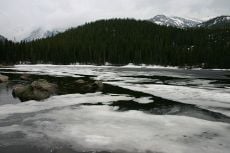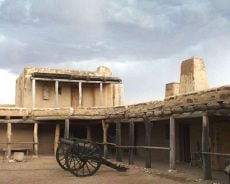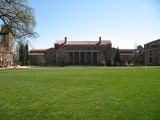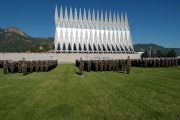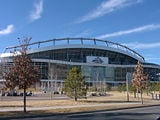Colorado
| State of Colorado | |||||||||||
| |||||||||||
| Capital | Denver | ||||||||||
| Largest city | capital | ||||||||||
| Largest metro area | Denver-Aurora-Broomfield MSA | ||||||||||
| Area | Ranked 8th | ||||||||||
| - Total | 104,094 sq mi (269,837 km²) | ||||||||||
| - Width | 380 miles (612 km) | ||||||||||
| - Length | 280 miles (451 km) | ||||||||||
| - % water | 0.36% | ||||||||||
| - Latitude | 37°N to 41°N | ||||||||||
| - Longitude | 102°03'W to 109°03'W | ||||||||||
| Population | Ranked 22nd in the U.S. | ||||||||||
| - Total | 5,116,796 (2011 estimate)[1] | ||||||||||
| - Density | 49.3/sq mi (19.0/km2) Ranked 37th in the U.S. | ||||||||||
| - Median income | $56,993 (13th) | ||||||||||
| Elevation | |||||||||||
| - Highest point | Mount Elbert[2][3][4] 14,440 ft (4401.2 m) | ||||||||||
| - Mean | 6,800 ft (2070 m) | ||||||||||
| - Lowest point | Arikaree River[2][3] 3,316 ft (1011 m) | ||||||||||
| Admission to Union | August 1, 1876 (38th State) | ||||||||||
| Governor | John Hickenlooper (D) | ||||||||||
| Lieutenant Governor | Joseph A. Garcia (D) | ||||||||||
| U.S. Senators | 2 – Mark Udall (D) 3 – Michael Bennet (D) | ||||||||||
| Time zone | MST=UTC-07, MDT=UTC-06 | ||||||||||
| Abbreviations | CO Colo. US-CO | ||||||||||
| Web site | www.colorado.gov | ||||||||||
Colorado is a state located in the Rocky Mountain region of the United States of America. It may also be considered as part of the Western and Southwestern regions. The state's population is one of the fastest growing, with many migrants coming from California and the U.S. East Coast. Denver is the capital and most populous city of Colorado.
Colorado is one of only four states in the United States to share a common border (known as Four Corners), along with Arizona, New Mexico, and Utah. It is one of three U.S. states, along with Wyoming and Utah, that lack any natural borders and have boundaries represented by only latitude and longitude lines.
From west to east, the state is comprised of desert-like basins turning into plateaus, then alpine mountains, and then the grasslands of the Great Plains. Colorado has more than 50 mountain peaks more than 14,000 feet tall, including Pikes Peak, whose lone peak is visible from near the Kansas border (190 miles away) on clear days.
Native American tribes have played an influential role in the state's settlement and culture. Both Plains Indians, mainly Arapaho and Cheyenne and Great Basin Indians, mainly Ute served as early guides and teachers to westward bound pioneers. At the same time, Colorado's historical legacy includes the infamous Sand Creek Massacre, in which as many as 400 unarmed Native Americans camped on the banks of the Sand Creek were attacked and lost their lives in the pre-dawn hours of November 29, 1864. Today Native place-names, folktales, music, and dance are a part of the Colorado culture, as are Native artwork and jewelry.
Geography
Colorado is defined as the geoellipsoidal rectangle that stretches from 37°N to 41°N latitude and from 102°03'W to 109°03'W longitude (25°W to 32°W from the Washington Meridian). Colorado, Wyoming, and Utah are the only three U.S. states that lack natural borders and have only lines of latitude and longitude for boundaries. When government surveyors established the border markers for the Territory of Colorado, minor surveying errors created several small kinks along the borders, most notably along the border with the Territory of Utah.[5]
The summit of Mount Elbert at 14,440 feet (4,401 m) elevation in Lake County is the state's highest point and the highest point in the entire Rocky Mountains.[2] Colorado is the only U.S. state that lies entirely above 1,000 meters (3,281 ft) elevation. The point where the Arikaree River flows out of Colorado into Kansas is the lowest point in the state at 3,315 feet (1,010 m) elevation, which is the highest low point of any U.S. state.[6][2]
Nearly half of the state is flat in stark contrast to Colorado's rugged Rocky Mountains. East of the Southern Rocky Mountains are the Colorado Eastern Plains of the High Plains, the section of the Great Plains within Colorado at elevations ranging from 3,315 to 6,562 feet (1,010 to 2,000 m). The states of Kansas and Nebraska border Colorado to the east. The plains are sparsely settled, with most population along the South Platte and Arkansas Rivers. Precipitation is meager, averaging from 12 to 18 inches (300 to 450 mm) annually. There is some irrigated farming, but much of the land is used for dry-land farming or ranching.
The bulk of Colorado's population lives along the eastern edge of the Rocky Mountains, a region partially protected from prevailing storms by the high mountains to the west. The densely populated area is beset with smog from its vehicles and factories.
The Continental Divide stretches across the crest of the Rocky Mountains. Water west of the Continental Divide drains west into the Sea of Cortez via the Colorado River.
Within the Rocky Mountains are several large parks or high broad basins. In the north, on the east side of the Continental Divide, is North Park. North Park is drained by the North Platte River, which flows north into Wyoming. Just south but on the west side of the Continental Divide is Middle Park, drained by the Colorado River. South Park is the headwaters of the South Platte River. To the south lies the San Luis Valley, the headwaters of the Rio Grande, which drains into New Mexico. Across the Sangre de Cristo Range, to the east of the San Luis Valley, lies the Wet Mountain Valley. These basins, particularly the San Luis Valley, lie along the Rio Grande Rift, a major geological formation, and its branches.
The Rocky Mountains within Colorado contain 53 peaks that are 14,000 feet (4,267 m) or higher elevation, known as fourteeners. The mountains are timbered with conifers and aspen to the tree line, at an elevation of about 12,140 feet (3,700 m) in southern Colorado to about 10,500 feet (3,200 m) in northern Colorado; above this, only alpine vegetation grows. The Colorado Rockies are snow-covered only in the winter; most snow melts by mid-August with the exception of a few small glaciers.
Much of the fame of Pikes Peak is due to its location along the eastern edge of the Rockies. Pikes Peak is the easternmost 4,200-meter (13,780 ft) mountain peak in the United States. Unlike most other similarly tall mountains in Colorado, it serves as a visible landmark for many miles to the east, far into the Great Plains of Colorado; it comes into view from a distance of more than 130 miles (210 km). On a clear day, the peak can be seen from Denver (over 60 miles (97 km) north), and from locations near the Kansas border to the east.
The region stretching from the San Juan Mountains in the southwest to Boulder and Central City contains most of the historic gold- and silver-mining districts of Colorado.
The Western Slope is generally drained by the Colorado River and its tributaries. Notable to the south are the San Juan Mountains, an extremely rugged mountain range, and to the west of the San Juans, the Colorado Plateau, a high desert bordering southern Utah. Grand Junction is the largest city on the Western Slope. To the southeast of Grand Junction is Grand Mesa, the world's largest flat-topped mountain. Farther east are the ski resorts of Aspen, Vail, Crested Butte, and Steamboat Springs. The northwestern corner of Colorado bordering northern Utah and western Wyoming is mostly sparsely populated rangeland.
Climate
The climate of Colorado is quite complex compared to most of the United States. The typical south-north/cooler-warmer variation in other states is not generally applicable in Colorado. Mountains and surrounding valleys greatly affect local climate. As a general rule, with an increase in elevation comes a decrease in temperature and an increase in precipitation. A main climatic division in Colorado occurs between the Rocky Mountains on the west and the plains on the east; the foothills form a transitional zone between the two.
Extreme weather
Extreme weather is a common occurrence in Colorado. Thunderstorms are common east of the Continental Divide in the spring and summer, and Colorado is one of the leading states with deaths due to lightning. Hail is a common sight in the mountains east of the divide and in the northwestern part of the state. While not as common as some of the states to the east, much of the Eastern Plains are prone to tornadoes. Floods are also a factor in the plains, partly due to heavy snow in the mountains followed by a warm, dry period that swells rivers with melted snow.
Colorado is also known for its droughts that occur every few years, causing major wildfires.
The highest temperature ever recorded in Colorado was 118°F (48°C) on July 11, 1888, at Bennett, while the lowest was -61°F (-52°C) on February 1, 1985, at Maybell.[7][8]
Eastern Plains

The climate of the Eastern Plains is a semi-arid continental climate of low humidity and moderately low precipitation, usually from 10 to 15 inches (250 to 380 mm) annually. The area is known for its abundant sunshine and cool clear nights. About 75 percent of the precipitation falls within the growing season, from April to September, but this area is very prone to droughts. Most of the precipitation comes in the form of thunderstorms, which are often severe, and the form of major snowstorms that happen most often in the early spring and in late autumn, and sometimes winter, from low pressures that bring the right conditions. Otherwise, winters tend to be drier and cold. The Front Range cities closer to the mountains tend to be warmer in the winter due to chinook winds that warm the area, sometimes bringing temperatures up to 60 °F (16 °C) or higher in the winter.[9]
West of the plains and foothills

West of the plains and foothills, the weather of Colorado is much less uniform. Even places a few miles (kilometers) apart can experience vastly different weather, depending on the topography of the area. Most valleys also have a semi-arid climate, which becomes an alpine climate at higher elevations. Generally, the wettest season is in the winter, while June is the driest month, which is the opposite of precipitation patterns in the east. The mountains have cool summers with many days of high temperatures around 60 °F (16 °C) and 70 °F (21 °C), although frequent thunderstorms can cause a sudden drop in temperatures. Summer nights are cool, or even cold at the highest altitudes, which can sometimes have snow in the middle of summer. The winters bring abundant, powdery snowfall to the mountains, which the skiers love. There can be many days with abundant sunshine in between major storms.
The Western Slope has high summer temperatures similar to those found on the plains, while the winters tend to be slightly cooler due to the lack of any warming winds that are common in the plains and Front Range. Other areas in the west have their own unique climate. The San Luis Valley is generally dry with little rain or snow.
Flora and fauna
Colorado's range of habitats, from plains to mountains, allows for a variety of both plant and animal life. Grasses predominate on the prairie, while pines, spruce, birch, aspen, and alder trees are found at the higher elevations. Above the treeline is an area of alpine tundra where more than 450 types of lichen grow. The mesas are covered with pines, sagebrush, and cacti.
The herds of buffalo, pronghorns, and deer that once thrived on the prairie have been replaced by smaller mammals: prairie dogs, foxes, coyotes, and small rodents.
The mountains are home to bears, mountain goats, deer, elk, moose, bighorn sheep, wolves, mountain lions, otters, martens, weasels, mink, and small rodents. Beaver, too, have returned.
Protected areas
Nationally Protected Areas in Colorado include:
- Four National Parks
Black Canyon of the Gunnison National Park, Great Sand Dunes National Park and Preserve, Mesa Verde National Park, and Rocky Mountain National Park.
Canyons of the Ancients National Monument, Colorado National Monument, Dinosaur National Monument, Florissant Fossil Beds National Monument, Hovenweep National Monument, and Yucca House National Monument.
- Two United States National Historic Sites
Bent's Old Fort National Historic Site and Sand Creek Massacre National Historic Site.
There are also 32 Historic and Scenic Trails, 2 National recreation areas, 11 National forests, 2 National grasslands, 7 National wildlife refuges, and 41 National wilderness areas.
History
The region that is today the state of Colorado has been inhabited by Native Americans for more than 13 millennia. The ancient Pueblo peoples lived in the valleys and mesas of the Colorado Plateau. The Ute inhabited the valleys of the southern and western Rocky Mountains. The Arapaho and the Cheyenne moved west to hunt across the High Plains.
Conflicting claims
The United States acquired a territorial claim to the eastern flank of the Rocky Mountains with the Louisiana Purchase in 1803. The U.S. claim conflicted with Spain's claim that a huge region surrounding its colony of Santa Fé de Nuevo Méjico was its sovereign trading zone.
The United States relinquished its claim to all land south and west of the Arkansas River as part of the U.S. purchase of Florida from Spain in 1819. Mexico won its independence from Spain in 1821, but it surrendered its northern territories to the United States after the Mexican-American War in 1848. The United States divided the area of the future Colorado among the Territory of New Mexico and the Territory of Utah (organized in 1850), and the Territory of Kansas and the Territory of Nebraska (organized in 1854).
Most American settlers traveling west to Oregon or California avoided the rugged Rocky Mountains and instead followed the North Platte River and Sweetwater River through what is now Wyoming. In 1851, Hispanic settlers from Taos New Mexico, settled the village of San Luis, then in the New Mexico Territory but now considered Colorado's first permanent European settlement.
Discovery of gold and silver
Gold was discovered along the South Platte River in western Kansas Territory in July 1858, precipitating the Pikes Peak Gold Rush. The placer gold deposits along the rivers and streams of the region rapidly played out, but miners soon discovered far more valuable seams of hard rock gold, silver, and other minerals in the nearby mountains.

The election of Abraham Lincoln as U.S. president in 1860 led to the secession of six slave states and the threat of civil war. Seeking to augment the political power of the free states, the Republican-led U.S. Congress hurriedly admitted the eastern portion of the Territory of Kansas to the Union as the free State of Kansas, leaving the western portion of the territory, and its gold fields, unorganized.
Thirty days later, outgoing U.S. President James Buchanan signed an act of Congress organizing the free Territory of Colorado.[10] The name Colorado was chosen because it was commonly believed that the Colorado River originated in the territory. Early explorers identified Colorado's Gunnison River as the headwaters of the Colorado River, though the Grand River (Colorado) was later identified as the headwaters. Finally in 1916, E.C. LaRue, of the United States Geological Survey, identified the Green River in Wyoming as the proper headwaters of the Colorado River.
On August 1, 1876, (28 days after the Centennial of the United States), U.S. President Ulysses S. Grant signed a proclamation admitting Colorado to the Union as the 38th state and earning it the moniker "Centennial State".[11]
The discovery of a major silver lode near Leadville in 1878 triggered the Colorado Silver Boom. The Sherman Silver Purchase Act of 1890 invigorated silver mining, but the act's repeal in 1893 led to a major collapse of the state's economy.
Colorado women were granted the right to vote in 1893, making Colorado the first U.S. state to grant universal suffrage by popular vote.
Modern period
By the 1930 census, the population of Colorado exceeded one million residents. The state suffered through the Great Depression and the Dust Bowl of the 1930s, but a major wave of immigration following World War II boosted Colorado's fortunes. Tourism became a mainstay of the state economy, and high technology became an important economic engine. Colorado's population exceeded 4.3 million by the 2000 census.
Government and Politics

The governor heads the state's executive branch. The Colorado Supreme Court is the highest judicial body in the state. The state legislative body is the Colorado General Assembly, which is made up of two houses, the House of Representatives and the Senate. The House has 65 members and the Senate has 35. The 2005 Colorado General Assembly was the first to be controlled by the Democrats in forty years.
Colorado is considered a swing state in both state and federal elections. Coloradans elected 17 Democrats and 12 Republicans to the governorship in the last 100 years. In presidential politics, Colorado supported Democrats Bill Clinton in 1992 and Barack Obama in 2008, and supported Republican presidential nominee Robert J. Dole in 1996 and George W. Bush in 2000 and 2004.
Colorado politics has the contrast of conservative cities and liberal cities. Democrats are strongest in metropolitan Denver, the college towns of Fort Collins and Boulder, southern Colorado (including Pueblo), and a few western ski resort counties. The Republicans are strongest in the Eastern Plains, Colorado Springs, Greeley, some Denver suburbs, and the western half of the state (including Grand Junction).
Economy
The state's economy broadened from its mid-nineteenth- century roots in mining when irrigated agriculture developed, and by the late nineteenth century, raising livestock had become important. Early industry was based on the extraction and processing of minerals and agricultural products. Current agricultural products are cattle, wheat, dairy products, corn, and hay.
The Bureau of Economic Analysis estimates that the total state product in 2006 was $230 billion. Per capita personal income in 2003 was $34,561, putting Colorado eighth in the nation. The federal government is a major economic force in the state with many important federal facilities including NORAD, United States Air Force Academy, Fort Carson (with a population of over ten thousand), and Peterson Air Force Base in Colorado Springs; the National Oceanic and Atmospheric Administration and the National Institute of Standards and Technology in Boulder; U.S. Geological Survey and other government agencies at the Denver Federal Center in Lakewood; the Denver Mint, Buckley Air Force Base, and 10th Circuit Court of Appeals in Denver; and a federal Supermax Prison and other federal prisons near Cañon City.
In addition to these and other federal agencies, Colorado has abundant National Forest land and four National Parks that contribute to federal ownership of 24,615,788 acres (99,617 km²) of land in Colorado, or 37 percent of the total area of the state.[12]
In the second half of the twentieth century, the industrial and service sectors expanded greatly. The state's economy is diversified and is notable for its concentration of scientific research and high-technology industries. Other industries include food processing, transportation equipment, machinery, chemical products, minerals such as gold and molybdenum, and tourism. Colorado also produces the largest amount of beer of any state.[13] The city of Denver is an important financial center.
Demographics
The state's most populous city, and its capital, is Denver. The Denver-Aurora-Boulder Combined Statistical Area, home to 2,927,911 people, contains more than two-thirds of the state's population.
The United States Census Bureau estimates that the state population was 4,861,515 in 2007, a 13.03 percent increase since 2000. Large numbers of new residents in the state originate from California, drawn by a lower cost of living and a healthier economy. Others moved in from East Coast states.
According to the 2000 census, the largest ancestry groups in Colorado are German (22 percent) (including of Swiss and Austrian nationalities), Irish (12.2 percent), and English (12 percent). Persons reporting German ancestry are the largest group in the state and are especially strong in the Front Range, the Rockies (west-central counties) and eastern parts/High Plains. Denver and nearby areas on the Front Range have sizable Scandinavian, Italian, Slavic, and Jewish American communities, partly a legacy of Gold Rushes in the late nineteenth century (1861-1889).
Colorado has one of the highest proportions of Hispanic citizens of any U.S. state, with over 19 percent reported in the 2006 census[14]; only five states have a higher percentage. Denver and some other areas have significant Mexican populations, while southern Colorado has a large number of descendants of early New Mexican settlers of colonial Spanish origin. The 2000 U.S. census reported that 10.52 percent of residents aged 5 and over in Colorado speak Spanish at home.
The state also has a history of African American communities which are located in northeast Denver in the Montbello, Green Valley Ranch, Park Hill, and Colfax Park areas. The state has sizable numbers of Asian-Americans of Chinese, Filipino, Korean, Southeast Asian, and Japanese descent.
With its median age of 33, Colorado has a higher number of younger persons, according to the 2000 census. Large numbers of married couples in professional careers with young children are moving to the state in a belief it's a better place to raise families. Colorado is also a major retirement destination by senior citizens in search of a warmer climate, recreation activities, and higher altitude, which is said to be healthier for those with respiratory diseases.
The Denver metropolitan area is considered more liberal and diverse than much of the state when it comes to political issues and environmental concerns, as the Denver area rapidly grows in size, sprawl and population in the last 40 years.
Religion
Colorado's population is predominately Christian, although it has a high percentage of religiously unaffiliated residents (like most other Western states). Colorado, and specifically Colorado Springs, serves as the headquarters of numerous Christian groups, many of them Evangelical. Focus on the Family is a major conservative Christian organization headquartered in Colorado Springs. Catholicism is popular in Colorado, and is becoming more so with the influx of Latino immigrants.
Major religious affiliations of the people of Colorado are:[15]
- Christian – 65 percent
- Protestant – 44 percent
- Evangelical – 23 percent
- Mainline – 19 percent
- Other Protestant – 2 percent
- Roman Catholic – 19 percent
- Latter Day Saint – 2 percent
- Protestant – 44 percent
- Jewish – 2 percent
- Muslim – 1 percent
- Other Religions – 1 percent
- Unaffiliated – 31 percent
The largest denominations by number of adherents in 2000 were the Roman Catholic Church with 752,505; the Church of Jesus Christ of Latter-day Saints with 92,326; and the Southern Baptist Convention with 85,083. [16]
Education
The Department of Education oversees 178 school districts serving over 800,000 students. Colorado offers a variety of options for elementary and secondary education: public schools, magnet schools, charter schools, homeschooling, and online classes.
There are 79 institutions of higher learning in the state, of which the oldest is the University of Denver, founded in 1864. Specialty schools include the U.S. Air Force Academy and the Colorado School of Mines.
Professional sports teams
Colorado is the least populous state with a franchise in each of the major professional sports leagues. The state is able to support the teams because it contains a large metropolitan area with a higher population than any other city within 550 miles (885 km). Therefore, many of the residents in the surrounding states support the teams in Denver, as shown by the reach of the Broncos' radio network, which includes affiliates in Kansas, Montana, Nebraska, Nevada, New Mexico, North Dakota, South Dakota, and Wyoming.[17]
The Colorado Rockies National League baseball club at Coors Field in Denver.
INVESCO Field at Mile High, home of the Denver Broncos National Football League club and the Denver Outlaws Major League Lacrosse club.
Pepsi Center in Denver, home of the Denver Nuggets National Basketball Association club, the Colorado Avalanche National Hockey League club, the Colorado Mammoth National Lacrosse League club, and the Colorado Crush Arena Football League club.
Looking to the future
Colorado's rapid population growth (2 percent annually) is placing increased demands on its highways, housing market, utilities, schools, and other services. Water is also an issue, as it is throughout the Southwest, and water conservation is mandated. Maintaining a balance between urban sprawl and the need to protect wilderness areas and wildlife habitats will continue to be a challenge.
Energy
Colorado has significant energy resources. According to the Energy Information Administration, Colorado hosts seven of the nation’s 100 largest natural gas fields and two of its 100 largest oil fields. Conventional and unconventional natural gas output from several Colorado basins typically accounts for more than 5 percent of annual U.S. natural gas production. Substantial deposits of bituminous, subbituminous, and lignite coal are also found in the state.
Colorado's high Rocky Mountain ridges offer wind power potential, and geologic activity in the mountain areas provides potential for geothermal power development. Major rivers flowing from the Rocky Mountains offer hydroelectric power resources. Corn grown in the flat eastern section offers potential resources for ethanol production. Notably, Colorado’s oil shale deposits hold an estimated 1 trillion barrels (160 km3) of oil – nearly as much oil as the entire world’s proven oil reserves. Oil production from those deposits, however, remains speculative.[18]
Notes
- ↑ Error on call to template:cite web: Parameters url and title must be specified (CSV). 2011 Population Estimates. United States Census Bureau, Population Division (December 2011).
- ↑ 2.0 2.1 2.2 2.3 Elevations and Distances in the United States. United States Geological Survey (2001). Retrieved October 21, 2011.
- ↑ 3.0 3.1 Elevation adjusted to North American Vertical Datum of 1988.
- ↑ The summit of Mount Elbert is the highest point of the Rocky Mountains of North America.
- ↑ Ivars Peterson, August 30, 2007, Rectangular States and Kinky Borders The Mathematical Association of America.
- ↑ U.S. Geological Survey. Elevations and Distances Retrieved December 1, 2008.
- ↑ National Climatic Data Center. 2004. Record Highest Temperatures by State Retrieved December 1, 2008.
- ↑ National Climatic Data Center. 2004. Record Lowest Temperatures by State Retrieved December 1, 2008.
- ↑ Western Regional Climate Center. Climate of Colorado Retrieved December 1, 2008.
- ↑ George P. Sanger, (ed.) 1863. The Statutes at Large, Treaties and Proclamations of the United States of America from December 5, 1859 to March 3, 1863. Vol. 12(Boston: Little, Brown and Company.), 172-177, An Act to provide a temporary Government for the Territory of Colorado Thirty-sixth United States Congress, February 28, 1861. Retrieved December 1, 2008.
- ↑ The American Presidency Project. Proclamation of the Admission of Colorado to the Union Retrieved December 1, 2008.
- ↑ Tony Frank. January 1997. Colorado Land Ownership by County (acres) Colorado Department of Agriculture. Retrieved July 15, 2007.
- ↑ Rob Reuteman. November 24, 2007. Colorado rides on Fat Tire to beer heights Rocky Mountain News. Retrieved December 1, 2008.
- ↑ Colorado Quick Facts.quickfacts. Retrieved December 23, 2008.
- ↑ The Pew Forum on Religion & Public Life. U.S. Religion Map and Religious Populations Retrieved December 1, 2008.
- ↑ The Association of Religion Data Archives. Colorado Denominational Groups, 2000 Retrieved December 1, 2008.
- ↑ Denver Broncos. 2007 Affiliate Stations Retrieved December 1, 2008.
- ↑ Energy Information Administration. State Energy Profiles: Colorado Quick Facts Retrieved December 1, 2008.
ReferencesISBN links support NWE through referral fees
- Cassells, E. Steve. 1997. The archaeology of Colorado. Boulder, CO: Johnson Books. ISBN 1555661939
- Gilfillan, Merrill. 1998. Chokecherry places essays from the High Plains. Boulder: Johnson Books. ISBN 1555662277
- Haruf, Kent. 1984. The tie that binds: a novel. New York: Holt, Rinehart, and Winston. ISBN 0030719798
- Kruger, Frances Alley, Carron A. Meaney, and John Fielder. 1995. Explore Colorado: a naturalist's notebook. Denver: Denver Museum of Natural History and Westcliffe Publishers. ISBN 9781565791244
- Somervill, Barbara A. 2008. Colorado. New York: Children's Press. ISBN 9780531185704
- Wiatrowski, Claude A. 2002. Railroads of Colorado: your guide to Colorado's historic trains and railway sites. (Pictorial discovery guide.) Stillwater, MN: Voyageur Press. ISBN 0896585913.
Gallery of images
External links
All links retrieved January 7, 2024.
- State of Colorado government website
- Colorado Department of Education
- Colorado state symbols and emblems
- Colorado State Agency Databases
Coordinates:
| Political divisions of the United States | |||||||
|---|---|---|---|---|---|---|---|
| |||||||
Credits
New World Encyclopedia writers and editors rewrote and completed the Wikipedia article in accordance with New World Encyclopedia standards. This article abides by terms of the Creative Commons CC-by-sa 3.0 License (CC-by-sa), which may be used and disseminated with proper attribution. Credit is due under the terms of this license that can reference both the New World Encyclopedia contributors and the selfless volunteer contributors of the Wikimedia Foundation. To cite this article click here for a list of acceptable citing formats.The history of earlier contributions by wikipedians is accessible to researchers here:
The history of this article since it was imported to New World Encyclopedia:
Note: Some restrictions may apply to use of individual images which are separately licensed.





